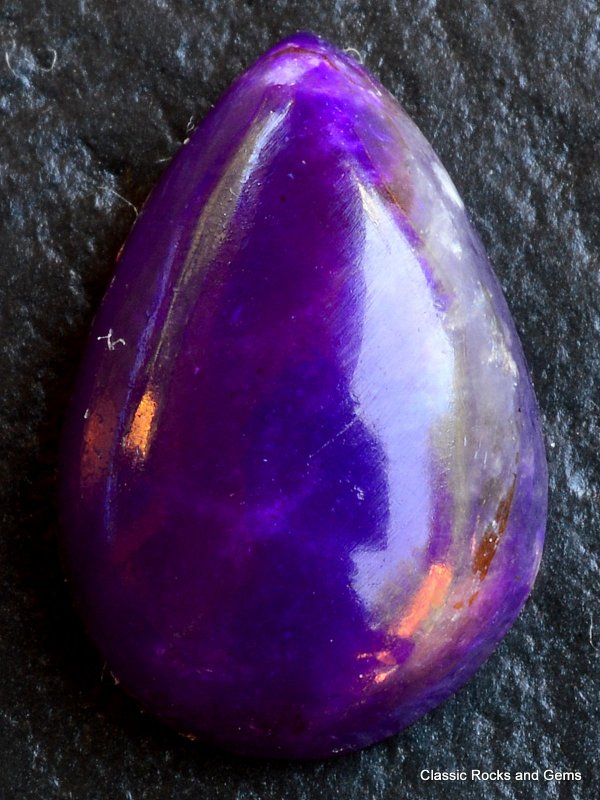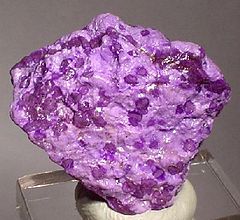

**************************
Examination of jewelry-quality sugilite shows that it consists of manganese-bearing sugilite and other minerals in a polycrystalline aggregate. The material occurs in a large stratiform manganese orebody at the Wessels mine near Kuruman, South Africa. Some 12 to 15 tons of sugilite of varying quality are estimated to occur at the mine. The attractive purple color is due to the presence of about 1-3 wt. % manganese oxide. The research reported here revealed that there are actually two types of gem materials that have heretofore been called sugilite: one that is predominantly manganoan sugilite with minor impurity minerals, and the other that is chalcedony mixed with (and colored by) sugilite.
Thls particular color of sugilite,
which originates from the Kalahari Manganese Mines
area of South Africa, is relatively
new to the gem market. It is also being
marketed under the trade names
Royal Azel and Royal Lavulite.
***************
| Sugilite | |
|---|---|
 Sugilite from Wessels Mine in Northern Cape Province, South Africa | |
| General | |
| Category | Cyclosilicate |
| Formula (repeating unit) | KNa2(Fe,Mn,Al)2Li3Si12O30 |
| Strunz classification | 09.CM.05 |
| Dana classification | 63.02.01a.09 |
| Crystal symmetry | Hexagonal dihexagonal dipyramidal H-M symbol: (6/m 2/m 2/m) Space group: P 6/mcc |
| Unit cell | a = 10 Å, c = 14 Å; Z=2 |
| Identification | |
| Color | Light brownish-yellow, purple, violet, reddish violet, pale pink, colorless |
| Crystal habit | Prismatic crystals, typically granular to massive |
| Crystal system | Hexagonal |
| Cleavage | Poor on {0001} |
| Mohs scale hardness | 6–6½ |
| Luster | Vitreous |
| Streak | White |
| Diaphaneity | Transparent to translucent |
| Specific gravity | 2.74 |
| Optical properties | Uniaxial (-) |
| Refractive index | nω = 1.610 nε = 1.607 |
| Birefringence | δ = 0.003 |
| Pleochroism | Weak |
| References | [1][2][3] |
Sugilite (/ˈsuːɡɨlaɪt/ SOO-gi-lyt), also known as lavulite, is a relatively rare pink to purple cyclosilicate mineral with the complex chemical formula KNa2(Fe,Mn,Al)2Li3Si12O30. Sugilite crystallizes in the hexagonal system with prismatic crystals. The crystals are rarely found and the form is usually massive. It has a Mohs hardness of 5.5 to 6.5 and a specific gravity of 2.75 to 2.80. It is mostly translucent.
Sugilite was first described in 1944 by the Japanese petrologist Ken-ichi Sugi (1901–1948) for an occurrence on Iwagi Islet, Japan, where it is found in an aegirine syenite intrusive stock. It is found in a similar environment at Mont Saint-Hilaire, Quebec, Canada. In the Wessels mine in Northern Cape Province of South Africa, sugilite is mined from a strata-bound manganese deposit. It is also reported from Liguria and Tuscany, Italy; New South Wales, Australia and Madhya Pradesh, India.
Note: The mineral is commonly pronounced with a soft "g", as in "ginger". However, as with most minerals, its pronunciation is intended to be the same as the person it is named after; in this case, the Japanese name Sugi has a hard "g", as in "geese".
